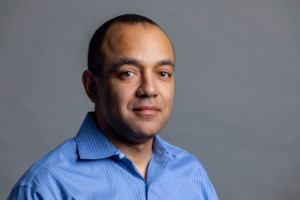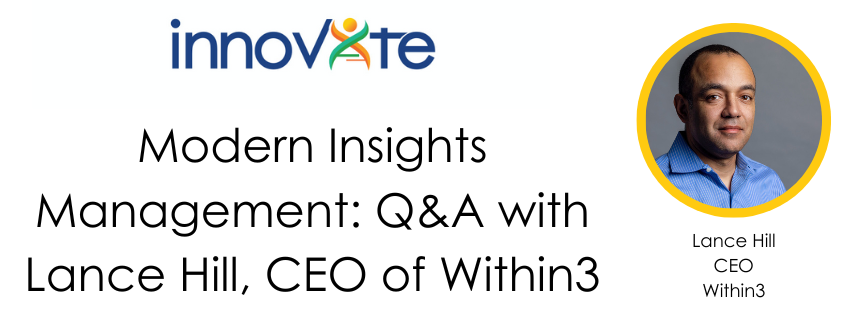
Medical Affairs organizations have the opportunity to modernize their operations in the pre-launch and launch phase by harnessing insights management technology. By building on their role as a value center within the larger organization, Medical Affairs is positioned to lead the way on this operational transformation with access to real-time insights and global visibility – often in a more cost-effective way than traditional methods. Here MAPS speaks with Lance Hill, CEO of Within3 about the challenges and best practices for making this transition to modern insights management.
—
MAPS: You describe Medical Affairs as a value center. Does everyone in the organization view the function this way?
Lance: Historically, it’s been difficult for Medical Affairs to demonstrate value – to show ROI to the groups left and right of them. A lot don’t see Med Affairs as a strategic asset. They see it as a cost center. It’s not sales. It’s not R&D. But when you step back, you see that Med Affairs brings understanding of the market and disease community – and is positioned to translate the heavy science coming out of R&D to what it means to patients and physicians. Medical Affairs generates the insights needed to understand what’s necessary scientifically and commercially to demonstrate the value of products coming through the pipeline.
MAPS: So R&D develops the products, Commercial markets the products and Med Affairs insights demonstrate the value of the product?
Lance: There’s a saying in marketing that He who has the voice of the customer is powerful. And Med Affairs is uniquely positioned for that – we can talk with customers in depth, in different ways. And it’s not just harnessing the voice of single customers – not just individuals – but en masse, from prescribers in one area of the world all the way to experts and thought leaders offering treatment guidelines.
MAPS: You bring up a good point that Medical Affairs doesn’t only generate insights from healthcare providers, but from a range of external stakeholders. And these insights aren’t just knowledge gaps, but a full understanding of the treatment landscape.
Lance: My definition of insights is things you are learning that can inform your strategy. Sure, you have the important one-on-one interactions like those in Field Medical. But then you also have small groups – your ad boards, steering committees, patient panels. And Medical Information – people who call the help desk. That’s a source of insights as well. You also have congresses, Like ASCO. You mobilize your entire company, everyone is there, and if you can successfully capture insights, the whole thinking accelerates 4 months in like 3 days. Or you have an entire disease community, maybe 10k physicians in a rare disease area and 2 million patients – there’s insights from that as a whole. Medical Affairs is in a position to ask What’s the shape of that? What’s the patient journey. On a high level, what are the treatment guidelines, market access, what’s required to demonstrate to a payer it belongs in the formulary? How does new information traverse that network? That ability to gain and harvest insights is a fundamental pillar of what makes Med Affairs valuable.
MAPS: You talk about diverse insights from diverse sources – do you also see diversity in the benefit of insights across the lifecycle?
Lance: I attended one of the MAPS MasterClasses last year and one of the speakers, Meg [Heim] was talking about the percentage of launches that are successful and it’s not great – a lot of launches were not wonderful due to misunderstanding what’s necessary to make the treatment successful. Maybe an organization has a good drug, but they just can’t get take-up. Insights help you understand what needs to be disseminated to who and how – otherwise you’re assuming. You’re thinking, This has worked for past launches – but what if it doesn’t? The conditions underlying launch are dynamic and you can’t just assume that old models work. So much is invested in getting to that launch point. It’s a pivotal moment and making a mistake because you didn’t ask the right questions or info came in but didn’t fit with how you were thinking about things – that’s a missed opportunity.
MAPS: Traditionally, we think of insights identifying things like gaps in HCP knowledge about prescribing, but you’re placing the role of insights much earlier, even in the pre-launch period.
Lance: What Medical can gain from prelaunch has become more powerful with improvement in technology and access to clean data. The ability to understand long before launch things like sentiment around a disease state and what conversations are taking place not just at congresses but in social media about things like competing therapies, you have real-time information around your audience – the humans in your audience, not just who publishes and speaks, but you can see which centers are seeing certain patients in and Real-World Evidence to help you understand where you should be fielding your field force. If you’re first to market, you’re probably doing something different than standard of care, so you need the ability to look at info earlier and have discussions with people who matter in the disease community – to help people understand a novel therapy and drive what additional evidence you might need, and how to disseminate that information. In previous years, we were blind, all we knew was who was listed in clinical trial information. Insights are a tremendous help in prelaunch.
MAPS: You mention real-time insights and that seems new, as well.
Lance: With everything moving digital, the speed at which information travels through a disease community is vastly accelerated and the speed at which new information makes a change in that community is also accelerated. You can’t take 180 days to gather insights and take 9 months and have an ad board – those strategies don’t work. If you’re taking that long, all you’re doing is confirming decisions the business already had to make. You can say that advisors or the market agrees or disagrees with what we’ve already had to do. Now Med Affairs can take that down to real time.
MAPS: How?
Lance: Well, there are certainly challenges. You’ve got these disparate buckets of insights that require different processes but then need to be integrated into one strategy. If it’s not apparent how information is helping strategy in this therapeutic area, it’s just noise. Medical has always been drinking from a fire hose of information, but in the last 2-3 years, it’s turned on even higher to the point it’s so high you can’t manage the flow of information and insights with yesterday’s best practices. It was fire-hosing already and now you add social media with people posting thoughts on social even before a poster is presented. They’re judging on social media every day and it has a massive influence on dissemination of thought and science. It’s very different than it was 5-10 years ago. It can’t just be that your MSL has a meeting on the calendar at 6 and here’s the deck. You’re going in there to ask 3-4 questions that directly contribute to imperatives in strategy, but also MSLs understand the need to listen for things outside these known questions.
MAPS: Right, there’s insights you know you need and insights you don’t know you need…
Lance: There’s certainly the danger of going out with a confirmation bias approach – to hear the things you already know or want to hear. But insights should be surprising. Healthcare is dynamic with a lot of companies developing lots of new treatments, so there’s always something you don’t know. When we use AI for insights generation, we set it listening for known things, but then we also ask what else is out there in the noise – what’s out there we weren’t necessarily looking for at the outset but what else is inside those signals that can be impactful? Maybe we find our assumptions on how referrals happen are wrong, or our assumptions on why adherence doesn’t happen is wrong, or our assumptions on why someone would or would not enroll in a study are wrong. And, oh by the way, as we’re listening, we learn that everyone is waiting till after ASCO to make any changes in how they treat patients – it’s freezing PCPs’ desires to move forward with new therapies. Medical Affairs is positioned to unearth those aha moments – things we didn’t expect. And every one of those things Med Affairs unearths can demonstrate value to functions to the left and right.
MAPS: Is Medical Affairs getting closer to this insights management capability?
Lance: We need technology to bring insights together and to analyze it in real time – to join the disparate swim lanes of how Medical operates and make it one cohesive view. Then, ultimately, you’re categorizing and ranking insights and scoring them against your strategy and expectations to understand if your strategy is working. That’s gold for a Medical executive. But it takes Tech companies investing in Medical. Tech investment in life science companies has had a huge footprint in Commercial. And there’s been a lot of development around R&D – a lot of tech for that. But Medical gets kind of left behind from a tech industry point of view. Medical has to inherit the CRM tool Commercial picked or the data tools R&D wants and has to make do with those choices from other functions. Look at venture investment in health sciences – it’s Commercial and R&D. But what we’re excited about, and other innovative companies are realizing this too, is that there’s a lot of opportunity to help Medical make a real leap forward. There’s a tailwind at Medical’s back in the absolutely unique position Medical is in to gain insights from interactions. It’s this unassailable asset that Medical has and organizations are realizing – it’s not just an expensive scientific help desk. Through insights, Medical is the voice of the customer.



